Corinne et Jean-Pierre Grossot >
Burgundy >
France|
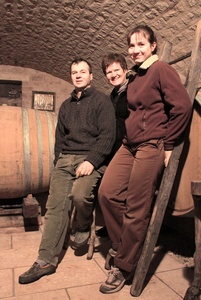 |
Corinne and Jean-Pierre Grossot, now joined by their daughter Eve, represent the third and fourth generations of winemakers at their family domaine. The estate is now counted among the elite of the appellation. The Grossots cultivate 18 hectares of vineyards centered in the village of Fleys, just east of the town of Chablis and on the right bank of the Serein River, which is recognized as the finest part of the Chablis appellation. Their production is about two-thirds Chablis AOC and one third (5 hectares) Premier Crus, including Mont de-Milieu, Vaucoupin, and Fourneaux. The Grossots seek to produce exceptional Chablis wines by keeping the rich, pure Chardonnay fruit, the unique mineral quality of the Kimmeridgian soil, and the lively fruity acidity and bouquet, in perfect balance. The grapes are hand-harvested and gently pressed in a horizontal pneumatic press to ensure the fullest extraction of flavors and aromas. The juice ferments very slowly at low temperatures in stainless steel tanks, and after a first racking, the wines rest mostly in tanks to develop. All wines undergo malolactic fermentation in all vintages. Bottling is usually done 12-18 months after the harvest.
Farming/winemaking practices: Certified Organic since 2015. By pruning severely, the vines have adequate aeration so the threat of problems requiring treatments (such as various forms of mildew and botrytis) is largely eliminated. The vines are fertilized when required by using only organic materials, the soil is plowed, and grass is planted between the rows. If necessary, the vines are minimally treated with a copper-sulfate mixture. Grossot recycles his vine cuttings as fuel for heating the domaine’s buildings. The wines are vegan. |
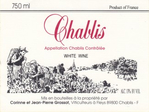 |
| Chablis |
The Grossots take great pride in their Chablis AOC, which comes from very well-placed sloping vineyards in the communes of Fleys, Chichée and Fontenay. They are able to produce such an exceptionally rich and expressive Chablis AOC because their grapes attain extra maturity, due to the excellent vineyards and their practice of keeping yields low. The soils are all Kimmeridgian limestone-clay with stones and sea-shell fossils. The Grossots usually harvest their Chablis AOC grapes beginning in the third week of September, when the fruit has reached an optimal balance of sugar, acidity and pH levels. The wine is aged on its lees in tanks for one year. The Chablis AOC is packed with flavors of ripe pear, citrus and minerals, and has a long, refreshing finish. Always enjoyable on release, it is the ideal introduction to the Grossot’s house style. 3000 cases made.
|
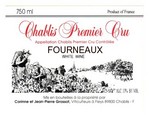 |
| Chablis - Fourneaux 1er Cru |
The Chablis 1er Cru Les Fourneaux comes from a steep, south-facing slope on the far side of Fleys, across the valley from the Grossot home and winery. Jean-Pierre replanted two, equal size parcels totaling 1.75 hectares in 1990 because of the vineyard’s enormous potential. The juice begins its fermentation very slowly at low temperature in stainless steel tanks. Three quarters of the volume completes its fermentation and maturation on fine lees in tanks. For the other 25%, the fermentation begins in tank and the fermenting juice is then transferred into a combination of 228 and 600 litre oak casks, which are between 1 and 5 years of age. This part of the cuvée completes its fermentation in barrels and is then aged, with occasional batônnage, in these casks until May. The parts are assembled in June and the Les Fourneaux is bottled in September, before the new harvest. This Premier Cru is always the most generous and accessible of the Grossot Premier Crus, offering expressive floral, ripe pear, citrus and mango flavors, a juicy texture, and a long, mineral finish. 700 cases made.
|
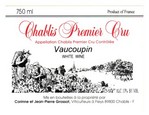 |
| Chablis - Vaucoupin 1er Cru |
The Chablis 1er Cru Vaucoupin vineyard is a very steep, south-facing slope in the commune of Chichée, on the south side of Fleys. The soil here is about half limestone and half clay. The vines in Grossot’s 1.6ha parcel on the upper part of the slope average 50 years of age. These factors contribute to the full-bodied, powerful and concentrated character of Grossot's Vaucoupin - as well as great minerality. The grapes are hand-harvested, sorted in the vineyards and again at the winery, and gently pressed in a horizontal pneumatic press to ensure the fullest extraction of flavors and aromas. The juice ferments very slowly at low temperature in stainless steel tanks, and after a first racking, the wine rests in tanks to develop on its lees. Grossot aims to balance the natural power and density of the Vaucoupin vineyard with finesse and soft acidity to produce a superb Chablis 1er Cru. It needs at least three to five years in bottle to be fully enjoyed, but can be cellared for over 10 years. 830 cases made.
|
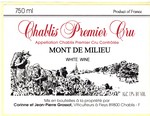 |
| Chablis - Mont de Milieu 1er Cru |
The family owns two-thirds of a hectare in the great, south-facing and steeply sloping Chablis 1er Cru Mont de Milieu vineyard, which borders the Grands Crus, near Fleys. The vines average 26 years of age and the soil is all Kimmeridgian limestone-clay with stones and sea-shell fossils. Two-thirds of the volume completes its fermentation and maturation on fine lees in tanks. For the other third, Grossot begins the fermentation in tank and then transfers the fermenting juice into a mix of 228 and 600 litre oak casks, which are between 1 and 5 years of age. This part of the cuvée completes its fermentation in barrels and is then aged in these casks, with occasional battonage, until March. Each part completes its malolactic fermentation separately. Grossot assembles the parts in June and bottles the Mont de Mileu in the second January after harvest. This is the Grossots’ most intense cru, combining remarkable structure, power and purity. The Mont de Milieu tastes of lemon cream, citrus and minerals, with stunning focus and persistence. It needs three to five years of bottle age to show all of its complexity and nuance and will benefit from extended cellar-time.
|

